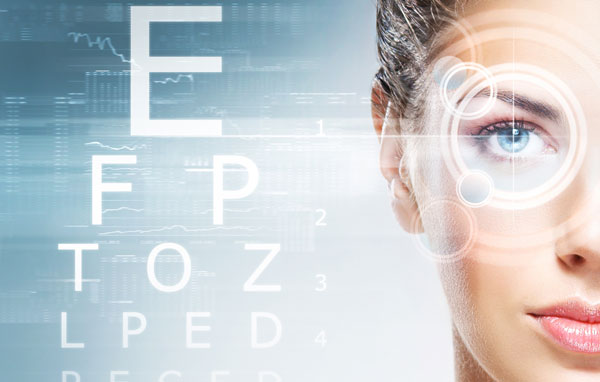
Bladeless LASIK: femtosecond laser-assisted cornea surgery is improving more people’s vision quality
A Dilemma of Choices
If you are suffering from vision degradation like myopia, hyperopia and astigmatism, you are probably considering LASIK (laser-assisted in situ keratomileusis) cornea surgery, so as to be forever unchained from glasses and contact lens. However, the final decision may be delayed by a difficult choice between two available plans: The old-school, well-established microkeratome-assisted LASIK (MK-LASIK), and the fashion-favored, rapidly-booming Bladeless LASIK (femtosecond laser-assisted LASIK aka FS-LASIK). What do the names of these techniques mean? How are they different from each other?
No Worries! Let’s Figure Out LASIK First
Before entering the clinic, a secure strategy is to inquire how your doctor is going to perform your treatment, and unlike other complicated operations, the principle of LASIK is very easy to understand. The theory of LASIK surgery derives from the structural resemblance between eyes and cameras. In our “biological camera”, cornea, a layer of transparent tissue, acts as an optical component that provides the major refractive force to focus the incoming light precisely on the “ film ” — retina. Via LASIK, surgeons manage to modify the cornea thickness and optimize the eye’s refractive ability, therefore correcting the visions of patients whose eyes fail to focus light properly. Below is schematic three-step procedure of a laser cornea surgery.
Step 1: Flap Creation
Surgeons will first hold your eye immobilized by a soft suction ring, and then cut through the cornea to create a hinged flap on the top of the cornea.
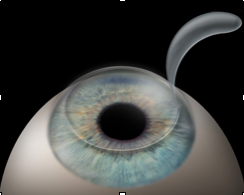
LASIK procedure 1: Flap creation
Step 2: Laser Remodeling
After the flap is folded back, a tracking system will trace the eye’s position and precisely direct the excimer laser of 193nm wavelength into the exposed corneal section. Due to the fact that excimer lasers do not generate heat on cornea, a finely calculated amount of tissue in the cornea will be removed (photoablation) while leaving the adjacent tissue intact.
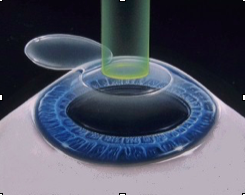
LASIK procedure 2: Cornea remodeling with an excimer laser
Step 3: Flap Re-position
After reshaping the treatment zone profile, surgeons will re-position the flap over the exposure area and check the fitting condition, the presence of bubbles and other debris.
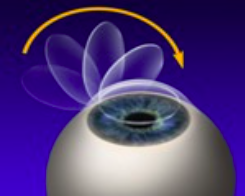
LASIK procedure 3: Flap re-position
Microkeratome vs Bladeless LASIK
What distinguish these two surgical plans are the different techniques used for the flap creation. In MK-LASIK, surgeons create flaps manually with a mechanical microkeratome that has an oscillating razor blade, whereas in Bladeless LASIK, the flap is cut “bladelessly” by a femtosecond laser that creates an array of tiny bubbles inside the cornea.
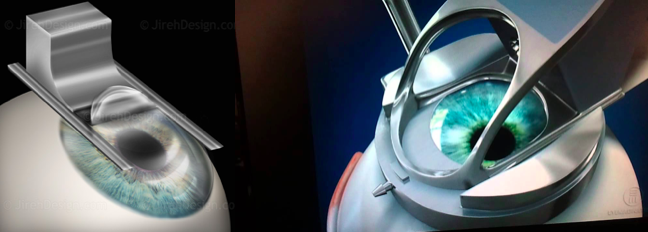
A flap created by a mechanical microkeratome
A Femtosecond (FS) laser is a laser that can generate ultrashort infrared pulses in the domain of femtoseconds ( 1 fs = 10-15 s, meaning that it is over a billion times faster than a single eye blink), and in Bladeless LASIK, the typical wavelength of a FS laser is 1053nm. Because it emits light so fast, FS lasers are able to deliver a small amount of energy before the collateral heating effect develops into thermal damage, making it an ideal surgical tool for delicate organs like eyes. After its first approval by FDA in 2001, FS lasers soon spread into the market at a tremendous speed, and have facilitated 30% LASIK surgeries in the U.S. in 2006. This number has roared to 68% in 2009.
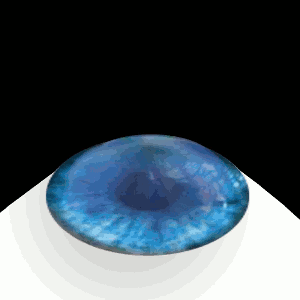
Flap creation in a Bladeless LASIK
It is obvious that the procedure where FS laser makes a huge difference is the flap creation, a fundamental step for subsequent treatments. Before introducing FS lasers to corneal surgeries, successful creation of flap relies heavily on the surgeon’s manual proficiency and clinic experience, for which the limited reliability is almost inevitable. Fortunately, the emergence of FS lasers has significantly lowered the inherent risks of the corneal surgery, and make possible other advantages over the tradition microkeratome.
Why Bladeless LASIK Wins Over MK-LASIK?
Therapeutic Outcomes
This is perhaps the most persuasive advantage of replacing the Microkeratome with a FS laser. After all, a fancy technique is only recognized when it satisfies the increasingly demanding patients, and FS laser does bring concrete results in terms of vision quality and stability. Researchers have found that, compared to the microkeratome group, eyes processed by FS lasers can not only better distinguish light and darkness (contrast sensitivity) in various conditions, but also exhibit much less vision errors (higher order aberration) like blur and double vision. Additionally, for myopic treatments, studies have shown that in the first 3 months after the Bladeless LASIK, 94.7% of the eyes score over 1.0 (decimal) in visual acuity tests without the help of glasses and contact lens, and maintained the results till 12 months. Furthermore, the remarkable stability and effectiveness also extend to hyperopic treatments by FS lasers.
Predictability & Safety
Another reason that Bladeless LASIK may soon dominate the market is that cornea flaps made by FS lasers boast unique safety, accuracy and predictability. While microkeratome operations have many uncontrollable variables and excessively emphasize surgeons’ hand-on experience, Bladeless LASIK platforms have already realized customization of the cornea parameters with a greater options of flap thickness, flap diameter, hinge position and cutting angle, etc, and the “bladeless lancet” are honed by finer laser sources and advanced computer algorithm. More importantly, medical studies have shown that corneas with thin uniform flaps are more stable than those with thicker flaps. Aided by FS, surgeons can achieve thin flap cutting on cornea much easier than with microkeratome, and therefore significantly reducing failure rate.
Side Effects
Finally, for those patients who care about long-term life qualify, FS-LASIK also comes with good news. The successful risks control and excellent therapeutic effects are not trade-offs of comfort during and after the operation. For example, in traditional cornea laser surgery, patients usually experience a momentary vision loss (blackout period) when their eyes are held by the suction ring. But in recent FS-LASIK platform, due to the use of a curved contact surface instead of a flat one in microkeratome, surgeons are able to create flaps in a gentler manner without causing blackout to the patients. Also, thanks to the reduced nerve damage by FS laser, medical researchers also found much fewer incidence of dry eye symptom, a common post-operation symptom encountered by over 90% laser cornea surgery patients.
Any Downside about Bladeless LASIK?
Unfortunately, yes. Although FS-LASIK offers an exciting alternative for MS-LASIK, it is still unable to guarantee perfect vision correction, and there are actually some complications specifically associated with Bladeless LASIK. For example, Transient light sensitivity syndrome (TLSS), which appears as photophobia with possible corneal inflammation in the first few weeks after the surgery. TLSS is believed to be a biochemical response to the infrared FS laser energy, or the possible inflammation in the adjacent tissues in cornea. The good news is that by using FS lasers with higher frequencies, the incidence of TLSS can be hopefully reduced. Another drawback of Bladeless LASIK is the so-called “Rainbow Glare”. Some patients after the surgeries reported seeing several bands of colors, and this phenomenon was found to be related to the higher laser energy used. By developing new FS lasers with better focusing optics, the incidence of “Rainbow Glare” is likely to decline.
Other Surgery Options?
Of course! For those who are concerned about the complications of LASIK, Wavefront Guided Photorefractive Keratectomy (PRK) provides a promising alternative for nearsightedness, farsightedness, etc. Instead of creating a flap as the first step, PRK will first remove the outer corneal layer which can later grow back, and then reshape the cornea middle section with an excimer laser. Aided with the advanced wavefront mapping technique, PRK can further customize inner corneal profile, and achieve an improved vision beyond glasses and contact lenses could. However, compared with LASIK, PRK usually have a longer recovery time and the procedure involves more pain.
Conclusion
In a word, FS lasers have profoundly revolutionized the modern cornea surgery. And before choosing a specific surgery, it is necessary to counsel your surgeons for individual conditions and suggestions.
Pictures in this article are presented with courtesy to google, wikipedia, and nwindianaeyeandlaser.com
For Further Reading
Tran DB, et al. Randomized prospective clinical study comparing induced aberrations with IntraLase and Hansatome flap creation in fellow eyes: potential impact on wavefront-guided laser in-situ keratomileusis. J Cataract Refract Surg. 2005;31(1):97–105.
Kanellopoulos AJ, et al. Long-term bladeless LASIK outcomes with the FS200 Femtosecond and EX500 Excimer Laser workstation: the Refractive Suite. Clin Ophthalmol. 2013;7:261–9.
Pajic B, et al. Femtosecond laser versus mechanical microkeratome-assisted flap creation for LASIK: a prospective, randomized, paired-eye study. Clin Ophthalmol. 2014;8:1883–9.
Knox Cartwright NE, et al. Effects of variation in depth and side cut angulations in LASIK and thin-flap LASIK using a femtosecond laser: a biomechanical study. J Refract Surg. 2012;28(6):419–25.

[…] Although laser ablation fulfills marking also through selective removal of materials, it differs from laser engraving in that the laser breaks chemical bonds immediately and therefore transforms the molecules into a cluster of plasma. As the process is usually carried out by pulses (e.g. from an excimer laser) whose duration is shorter than heat diffusion, collateral damage to surrounding materials can be significantly avoided, and the marks arise as a result of the contrast between the substrate and the ablated regions. The technique may be used on homogeneous materials as well as the layered substrates, and one typical application is the femtosecond laser aided cornea surgery. […]
Surprisingly advanced technology!
What are the rates for your Eye Lasik Surgery? My age is 40 years.What else do you need to give me exact rates for my eyes Lasik surgery? I live in Encino, CA 91436
This is the advanced technology, You taught the audience step by step.
There are many benefits of Lasik Surgery for many of the eye problems. I have found LASIK surgery very quick, painless, and accurate. Your article is worth reading. Can you please tell us which are the latest lasik machines for lasik surgery? I found VisuMax® laser , Wavelight EX500 Excimer Laser and Contoura™ Vision Topography Guided LASIK at Excel Laser Vision Institute in Orange County. I want to be sure these are the latest.
Grateful for the detailed insight into Bladeless LASIK, shedding light on its advantages in terms of safety, predictability, and therapeutic outcomes.